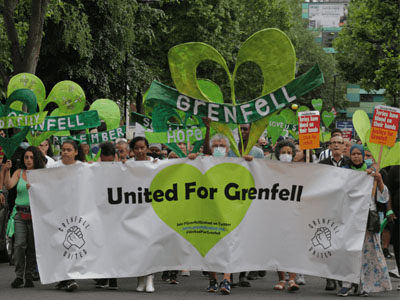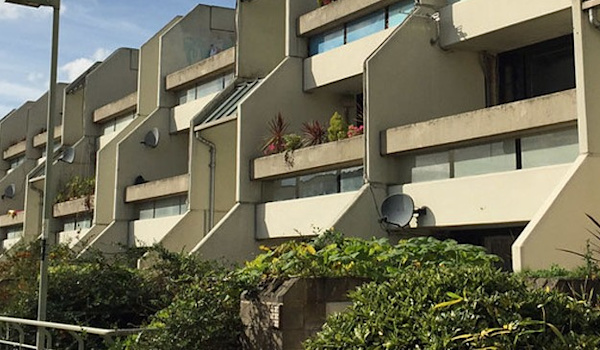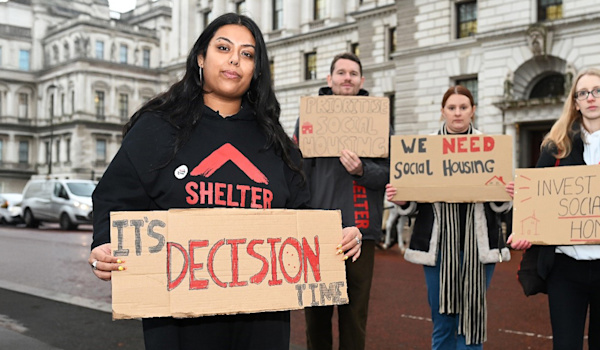For generations, social housing played a vital role in meeting the housing needs of people across the country, giving millions the quality and dignity of life that insecure and unaffordable private renting could not. Today, England's much-reduced stock of social housing continues to shrink, making it tightly rationed and unable to play the same role.
The story of social housing
How did we go from a golden era of social housebuilding to the housing emergency we face today?
Where it began
Social housing in this country dates back to the late 19th century, but the 1919 Housing and Planning Act saw the government embark on the first comprehensive plan to build social housing. Led by councils, this plan was the foundation of a large-scale building programme that stretched through to the latter half of the 20th century.
After the Second World War
Post-war governments faced the persistent problem of privately rented slums, the destruction of war, and the need to house returning soldiers. They set out an even bigger vision for social housing. Various political parties carried out social housebuilding programmes that provided millions of ordinary people with the stability of long-term tenancies at affordable rents.

Pictured: The Braunstone Estate, Leicester, England (with 1930s built social housing) c.1960
4.4 million new social homes built in the 35 years following the end of the Second World War
126,000 social homes built per year on average - a truly unbelievable rate of house building by today's standards
1980
1980 saw 94,140 new social homes built. However, the 80s marked a significant shift in social housing policy: Margaret Thatcher’s government allowed sitting tenants to buy their social homes at a substantial discount through Right to Buy.
At the same time, the powers and resources that local authorities previously had to build and manage social housing faced new restrictions. By 1983, social housebuilding had halved in just three years to 44,240.
1988
The Housing Act 1988 was an attempt to return to social housebuilding, led by housing associations rather than councils and backed up by private finance.
Since then, housing associations have delivered most of the few new social homes built in recent years. However, social housing providers of all kinds have lacked access to the resources and powers needed to come close to meeting housing demand.
As a result, social homes have been sold off faster than they have been replaced, and local authorities today have been left with just a fraction of the social homes they once had to offer.
2011
The government introduced Affordable Rent, and the legal definition of social housing was expanded. This began the diversion of funding to other less affordable tenures.
Society begins to feel the impact
2017
Due to the deregulation of consumer standards and a lack of investment in good quality social homes, some tenants faced health and safety risks in their homes. Many others felt stigmatised and ignored. This became painfully evident in the catastrophic fire at Grenfell Tower in North Kensington, London, in June 2017, in which 72 people (including 18 children) died.
2018
In response to the fire, Shelter launched its Social Housing Commission. This aimed to give social housing tenants across the country, starting with the Grenfell community, a far louder say in the future of social housing. Chaired by Reverend Mike Long of Notting Hill Methodist Church near Grenfell Tower, it brought together a panel of sixteen key figures to examine the role of social housing in ending the housing emergency. They included Grenfell Tower survivor Edward Daffarn, Ed Miliband MP, Baroness Sayeeda Warsi, Baroness Doreen Lawrence, Lord Jim O’Neill and TV architect George Clarke.
The Commission was overwhelmed by the public response and support for social housing. More than 31,000 organisations and people participated, sharing evidence and their experiences and welcoming commission members into their homes. Based on extensive research, the Commission launched its ‘Vision for Social Housing’ in 2019, calling for investment in a new generation of social homes, stricter regulations and a stronger voice for tenants.
2020
The coronavirus pandemic brought a societal focus on the value of home as it became vital to keeping safe from the virus. As part of this, the government introduced welcome emergency measures protecting social tenants from eviction and rent increases. However, the overcrowding in social housing, poor conditions and the number of people in temporary accommodation laid bare the desperate need for more quality social homes.
In December of this year, two-year-old Awaab Ishak died as a result of damp and mould in his home in Rochdale, Greater Manchester. The 2022 coroner’s report recommended action to prevent future deaths. Sheter supported the ‘Awaab’s Law’ campaign to ensure landlords were legally required to meet timescales for responding to serious hazards.
Social housing today
2023
In July 2023, the government finally passed the Social Housing (Regulation) Act. This laid out the foundations for changes in social housing management. It includes increased regulation of social landlords and new rules for protecting tenants from serious hazards in their homes. It paves the way for significant changes and improvements to the social rented sector.
In the months and years following the Grenfell fire, the bereaved, survivors, and residents organised to campaign for change as a legacy of those who died. Grenfell United campaigned for stricter regulation and a voice for tenants. They spent almost six years relentlessly fighting for justice alongside other social tenants nationwide, including social tenant campaigners Rob Gershon and Kwajo Tweneboa.

Pictured: Silent walk for Grenfell by Steve Eason
2024
In 2022-2023, we lost 11,700 more social homes than we gained. Combine this with rising house prices, and it’s easy to see why more and more people have no option but to try getting by in insecure and often unaffordable, privately rented housing.
After the Levelling Up and Regeneration Act 2023 reached Royal Assent, a decades-old law was amended, giving local authorities and other public bodies a tool to buy land at a fairer price. The tool was the removal of ‘hope value’, which prices land at what it could be worth if, hypothetically, future high-value property were built instead of social homes, a GP surgery, or a school.
Starting on 30 April 2024, councils can apply to the government to remove ‘hope value’ when using compulsory purchase powers as a last resort to acquire land. This removal can only apply if the prospective use of the land is for social homes or health and education facilities. For decades, Shelter has fought for land to be purchased at a fair price so that councils can build more social homes, reducing homelessness and ending the housing emergency in their communities.
1.4 million fewer social homes today than in 1980
164,040 children are now stuck homeless in damaging temporary accommodation, up 15% in a year
1.3 million households on social housing waiting lists
More than £12 billion a year is spent on housing benefit for private renters
This number has increased by 83% in real terms since 1994 and shows the knock-on effect of social housing loss. Millions more people on low incomes who previously would have been able to live in an affordable social home instead have to rely on the expensive and insecure private rented sector.
Where we’re heading
Simply put, not enough housing has been built to meet the country’s needs. Increasing numbers of households who would benefit from a social home are being left to compete for a shrinking number of available properties, the quality of which has also suffered because of a lack of continued investment.
More people will become stuck in unaffordable, overcrowded, insecure housing – especially families and older people; many individuals and families will experience homelessness.
At the start of the 1980’s nearly 1 in 3 households lived in social homes, but today social housing has lost its universal status as a home for everyone. It has become an overstretched ambulance service, relying on ageing infrastructure.

Our plan for the future
The government could end the housing emergency by delivering 90,000 new social homes a year by 2029. Could you help us make this happen?
Join the campaignDo you need housing advice?
Find out how to apply for social housing (often called council housing)
Explore Easy Read advice on housing
More about social housing

What is social housing?

The value of social housing

